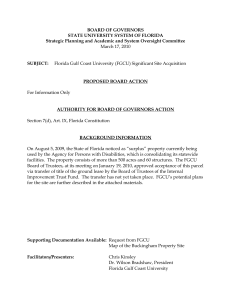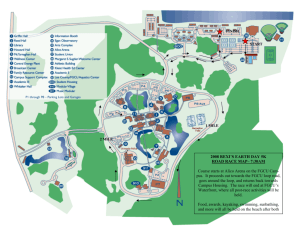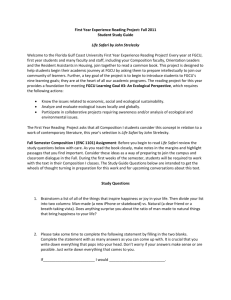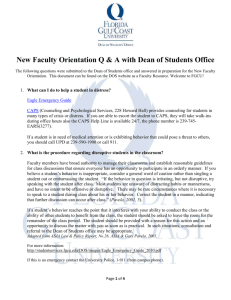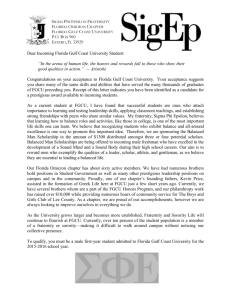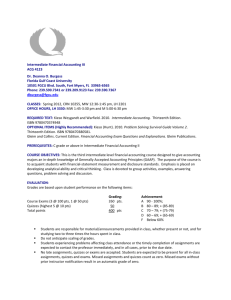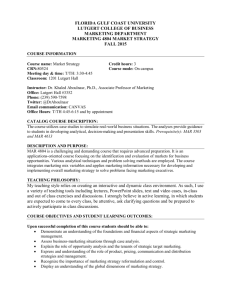Power point presentation - Florida Gulf Coast University
advertisement
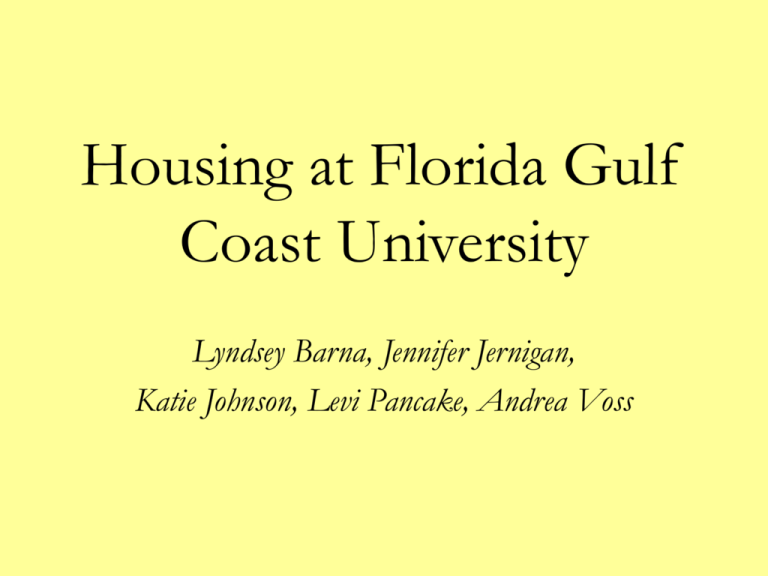
Housing at Florida Gulf Coast University Lyndsey Barna, Jennifer Jernigan, Katie Johnson, Levi Pancake, Andrea Voss Overview of Presentation • Why we chose this topic – Issues and Survey • Video • Past – What Housing was like before this year • Present – Waiting List – Student’s Perspective – Economics of Housing • Future – South Campus Housing – Master Plan • Conclusion • Solutions The Issues • Overpopulation of Housing in August 2006 • High cost for on-campus living • Population vs. beds next year? Housing Survey • Interviewed 100 students at FGCU • 44% said Housing was overcrowded – All Juniors or Above • All said they liked Apartment-Style Living • 62% said Housing was Affordable The Past North Lake Village 1998-2005 The Early Stages • Plans to build a new university on a 760-acre piece of land were started in 1991* • In 1996, FGCU set aside approximately 10 acres for housing and another 22 acres for future oncampus housing • The need for on-campus housing was due to: • The nearest colleges, USF and FIU, were some 150miles away • 18-25-year-olds are one of the fastest growing age groups in SWFL • Housing at FGCU would attract students who want to leave home but remain in the area Where would the Residence Halls go? • Two locations were proposed – The parcel adjacent to the lakefront – The parcel southeast of the academic core • Option #1 was chosen; campus broke ground on December 17, 1997 • August 1998, Phase I of housing completed: – 6 buildings (A, B, C, D, E, F) – 250 beds – 200 students to live in Phase I What style of housing? • FGCU wanted to build a community in both classroom and living arrangements* • Apartment-style housing, “would allow for the adaptation to be new freedom of college living with the responsibility of cooking and housekeeping. Additionally, it promotes group interaction and supervision by the residence life” (FGCU Housing Proposal). Phases I-VII and beyond… • By 2000, Phases I and II were completed: – “538 beds, representing approximately 15% of the Year 2000-2001 headcount enrollment (3,666 students)” (Master Plan, 2000-2010). • Phases III (M, N, O) – completed in 2001 • Phase IV (P) – completed in 2002 • Phase V (S, T, Honors) – completed in 2003 • Phase VI (Cypress, Oak, Mangrove) – completed in 2004 • Phase VII (Falcon, Sandpiper, Pelican, Egret) – completed in 2005 • Today, North Lake Village consists of Phases I-VII, with over 1900 students as residents. • As the pattern continues, FGCU will again break ground to expand its need for more on-campus housing. FGCU Master Plan for OnCampus Housing Background 2000-2010 Campus Master Plan • Introduction – Review and comparison of other universities • 8.6% Opening year 10 years 2008 20 years 2018 Projected head count 1800 8100 16200 Total beds at 8.6% headcount 155 beds 697 beds 1393 beds Current Conditions 2005-2015 Campus Master Plan Projected Housing Need Year Projected enrollment Total on campus housing need Increment 2006-2007 8,237 1958 existing beds 2008-2009 10,986 2637 678 2010-2011 13,274 3186 549 2015-2016 18,017 4324 1138 Percentage of other university housing • Florida Atlantic University Students: 26,000 Beds in housing: 1400 % of students being housed: 5% • University of South Florida Students: 41,392 Beds in housing: 4100 % of students being housed: 9% The Present North Lake Village 2006-2007 Housing Mission: “To provide students with a successful oncampus living/learning residential experience.” Housing Styles • Single Bedroom Apartment – – – – – – 4 Residents 4 Bedrooms 2 Bathrooms Living Room Kitchen $2355 per Semester • Double Bedroom Apartment – – – – – – 4 Residents 2 Bedrooms 2 Bathrooms Living Room Kitchen $1955 per Semester Current Housing Options • • • • Regular Honors Building Wellness Hall Nursing Hall Waiting List? • 500 person waiting list in Fall 2006 – Largest in School History – Many Upset Students • What was done about it? – Release contract with current students – Let waiting list student know other options – No Show Roster What Makes On-Campus Living Successful? • • • • • Programming Apartment Style Living Hiring Well-Trained Staff Convenient and No Where Else to Live Tram System From interview with Sholando Campbell Economics of FGCU Student Housing • Economics aspect of housing is a complicated process • Housing does not work alone- many people involved • Students believe housing fees are too expensive and housing makes huge profit • Many payments and expenses housing is responsible for • Housing goal is to provide a comfortable and safe living environment Economics of FGCU Student Housing • Housing receives no funding from the university or from the state (considered an auxiliary) • Housing must rely on other sources for money • Borrows money from a Finance Corporation, which is a nonprofit company • This corporation uses investors to provide large amounts of money to housing • Money is used to build residential halls and help them operate along with other expenses • Housing will eventually have to pay the Corporation back plus interest using the revenue made • A payment schedule is set up where big portions of the loan are paid for example every two years Overview of Expenses 17% 34% 5% 3% Operating Account Debt Service Maintenance Reserve Overhead Capitol Improvement 41% Overview of Expenses 1. Operating Account: most important part; has many pools that need to be taken care of financially • Full time staff pool & temporary staff pool: pays all housing • • • • employees and includes income, retirement, social security, benefits, etc. Supply & event pool: pays for equipment that needs funding for maintenance of the apartments like tools, parts & supplies; also pays for materials used in housing programs or events Chargeback pool: pays the university back for services they perform for housing like telephone lines Utilities pool: pays for all the bills that keep housing up and running, for example electricity, light, internet connections, etc. Travel pool: finances air fare or travel expenses for any housing employees that are required to take trips to conferences or anything else job related Overview of Expenses 2. 3. 4. 5. Debt Service: largest portion of the pie; responsible for paying the mortgage of the residential halls and is used to pay back the Finance Corporation Capitol Improvement: is used to fix any minor problems that occur with any of the residential halls like paint jobs, new furniture, wall repair, lighting, etc. Overhead: pays for services that are not handled by housing directly like providing additional money to the income of campus police officers Maintenance Reserve: resembles a bank account where money is put away and saved for emergency situations like hurricane damage Increasing Rental Rates Year Single Double Room Room 1998-1999 $1,937 $1,604 1999-2000 $1,937 $1,604 2000-2001 $2,000 $1,650 2001-2002 $2,000 $1,650 2002-2003 $2,100 $1,700 2003-2004 $2,100 $1,700 2004-2005 $2,200 $1,800 2005-2006 $2,200 $1,800 2006-2007 $2,345 $1,919 • Every two years housing costs are increased • Completely necessary due to inflation and competition between other neighboring universities • Increase number of bed spaces increase operating prices (directly proportional) • Operating expenses direct whether or not housing fees will be increased • Additional revenue is not pocketed by housing – goes directly to operating account Increases in Operating Expenses 2003-2004 (Actual) 2004-2005 (Actual) Capacity 1378 1662 % increase from previous year N/A 20.10% Electric $379,427.56 $522,668.93 Electric Per bed space $275.35 $314.48 Water/Sewage $143,066.39 $208,125.34 Water/Sewage Per bed space $103.82 $125.23 Garbage Removal $41,486.65 $55,323.08 Garbage Removal Per bed space $30.11 $33.28 Rental Rate Comparisons Institution Occupancy 2005-2006 Rates UNF Double $1,555 UWF Single $2,270 Double $1,955 UF Single $2,182 FGCU Single $2,210 Double $1,810 Single $2,458 Double $1,880 FSU Single $2,470 UCF Single $2,525 FIU Single $3,162 Double $2,028 USF Rental Rate Comparisons FGCU 9-month contract Coastal Village 9-month contract College Club 9-month contract Rent $4,400 $5,400 $5,310 Nonrefundable Fees $20 (RHA) $185 $250 Housing increases are necessary because if they were to dip into other sections of the pie to help pay for the increasing operating expenses, there wouldn’t be enough money for emergencies or for the mortgage since it was used for something else The Future South Lake Village South Campus Housing • Developed in 2 - 3 years • After Completion – Between 3,000 and 5,000 Beds • Suite Style – 4 Residents – 4 Bedrooms – No Living Room or Kitchen Area • Desire for a Strong Upper Classman Population Southern District of Campus • Single Suites – – • 4-6 students sharing bathroom and living space May be targeted towards sophomores and incoming transfer students but will be available to everyone. First Year experience halls – Single occupancy bedrooms and semi-private bathrooms (1:4 ratio) but will be without living room area. Proposed Phasing of Southeast District of campus Year Beds Added Housing Type Total Campus Housing Capacity Fall 2008 600 Single suites 2,558 Fall 2010 600 First Year 3,158 Fall 2012 600 Single Suites 3,758 Fall 2014 600 First Year 4, 358 Fall 2009 Dining Center Phase 1 Fall 2013 Dining Center Phase 2 • http://www.fgcu.edu/MasterPlan/Files/FGC U2005CMPdiagrams2-1.pdf So what really is the issue? • Lack of Knowledge • False Assumptions • Hearsay So what can we do? 1. Research the growth of Florida Gulf Coast 2. Ask the questions and find answers: http://studentservices.fgcu.edu/Housing/ Dr. Pam Schreiber – Director of Housing Anita Spohr, Office Manager E-mail: aspohr@fgcu.edu 3. Attend or join RHA What is RHA? “RHA is the Resident Housing Association comprised of the students who live in North Lake Village at Florida Gulf Coast University. RHA is funded separately through housing fees that allow the organization to develop social, educational, and leadership programs for residents opening doors to infinite opportunities.” http://rhaclub.fgcu.edu/RHA%20Rap.MPG References • • • • Comprehensive Campus Master Plan, 2000-2010: Data Inventory and Facility Needs Analysis (Vol. 1). (December 2000). Florida Gulf Coast University. Florida Gulf Coast University Student Residences Groundbreaking Ceremony. (December 1997). Moments in History. McKinney, Charles. (September 1994). Student Housing: A Discussion Paper. Student Residence Project: Request for Proposal 97P-006. (November 1996). Florida Gulf Coast University. • Andrade, Andres. Personal Interview. 23 Oct. 2006. • Campbell, Sholondo. Personal Interview. 20 Sep. 2006. FGCU Master Plan 2005-2015
